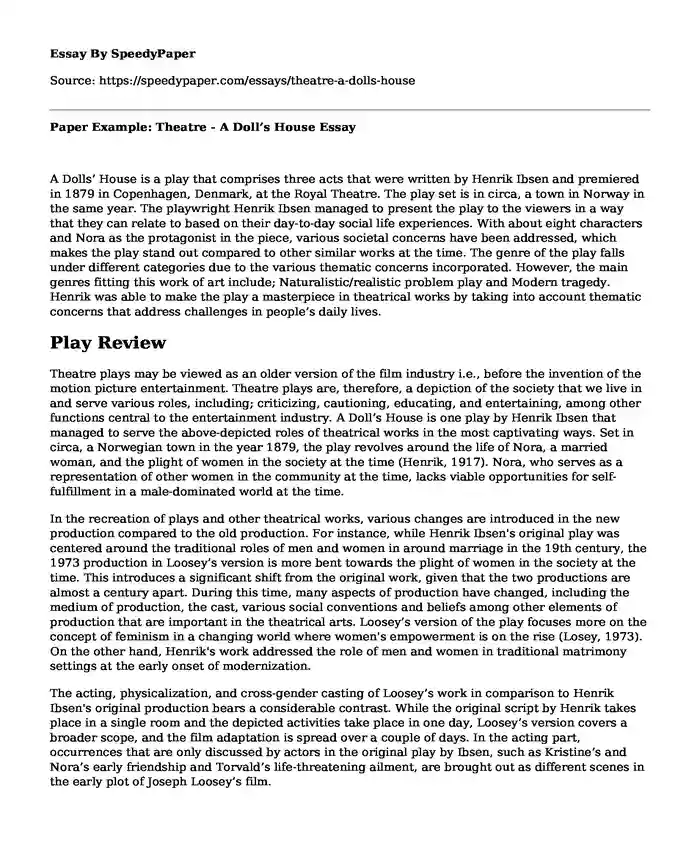
| Type of paper: | Essay |
| Categories: | Theatre Dramatic literature |
| Pages: | 3 |
| Wordcount: | 691 words |
A Dolls’ House is a play that comprises three acts that were written by Henrik Ibsen and premiered in 1879 in Copenhagen, Denmark, at the Royal Theatre. The play set is in circa, a town in Norway in the same year. The playwright Henrik Ibsen managed to present the play to the viewers in a way that they can relate to based on their day-to-day social life experiences. With about eight characters and Nora as the protagonist in the piece, various societal concerns have been addressed, which makes the play stand out compared to other similar works at the time. The genre of the play falls under different categories due to the various thematic concerns incorporated. However, the main genres fitting this work of art include; Naturalistic/realistic problem play and Modern tragedy. Henrik was able to make the play a masterpiece in theatrical works by taking into account thematic concerns that address challenges in people’s daily lives.
Play Review
Theatre plays may be viewed as an older version of the film industry i.e., before the invention of the motion picture entertainment. Theatre plays are, therefore, a depiction of the society that we live in and serve various roles, including; criticizing, cautioning, educating, and entertaining, among other functions central to the entertainment industry. A Doll’s House is one play by Henrik Ibsen that managed to serve the above-depicted roles of theatrical works in the most captivating ways. Set in circa, a Norwegian town in the year 1879, the play revolves around the life of Nora, a married woman, and the plight of women in the society at the time (Henrik, 1917). Nora, who serves as a representation of other women in the community at the time, lacks viable opportunities for self-fulfillment in a male-dominated world at the time.
In the recreation of plays and other theatrical works, various changes are introduced in the new production compared to the old production. For instance, while Henrik Ibsen's original play was centered around the traditional roles of men and women in around marriage in the 19th century, the 1973 production in Loosey’s version is more bent towards the plight of women in the society at the time. This introduces a significant shift from the original work, given that the two productions are almost a century apart. During this time, many aspects of production have changed, including the medium of production, the cast, various social conventions and beliefs among other elements of production that are important in the theatrical arts. Loosey’s version of the play focuses more on the concept of feminism in a changing world where women's empowerment is on the rise (Losey, 1973). On the other hand, Henrik's work addressed the role of men and women in traditional matrimony settings at the early onset of modernization.
The acting, physicalization, and cross-gender casting of Loosey’s work in comparison to Henrik Ibsen's original production bears a considerable contrast. While the original script by Henrik takes place in a single room and the depicted activities take place in one day, Loosey’s version covers a broader scope, and the film adaptation is spread over a couple of days. In the acting part, occurrences that are only discussed by actors in the original play by Ibsen, such as Kristine’s and Nora’s early friendship and Torvald’s life-threatening ailment, are brought out as different scenes in the early plot of Joseph Loosey’s film.
The acting of the film is, therefore, one aspect that contributes to the production of theatrical work differently. For instance, the adaptation of the theatre plays into a motion picture film acted by characters depicting those in the movie. It enables the members of modern society to relate with the new production as some of the aspects of the older production have become obsolete over time. As a result, the film adaptation could be viewed as essential in keeping the original play by Henrik Ibsen relevant even with the passing time.
References
Joseph Losey, World Film Services, & Tomorrow Entertainment (Producers), & Losey, J. (Director). (1973). A doll's house. [Video/DVD] Shout! Factory. Retrieved from https://libproxy.library.unt.edu:4498/watch/a-doll-s-house-2Ibsen, Henrik. A doll's house: and two other plays. No. 494. JM Dent, 1917.
Cite this page
Paper Example: Theatre - A Doll's House. (2023, Aug 29). Retrieved from https://speedypaper.com/essays/theatre-a-dolls-house
Request Removal
If you are the original author of this essay and no longer wish to have it published on the SpeedyPaper website, please click below to request its removal:
- Whistler's "Arrangement"
- Free Essay on A Haunted House by Virginia Woolf
- The Multi Cockroach Catcher - Free Essay with Product Research
- Free Essay Example on the Men's Fashion Industry
- Literary Essay Sample: Irony in "The Story of an Hour" by Kate Chopin
- Essay Sample with the Book Review of Evicted by Matthew Desmond
- Symbolism in Their Eyes Were Watching God, Literary Essay Sample for You
Popular categories




